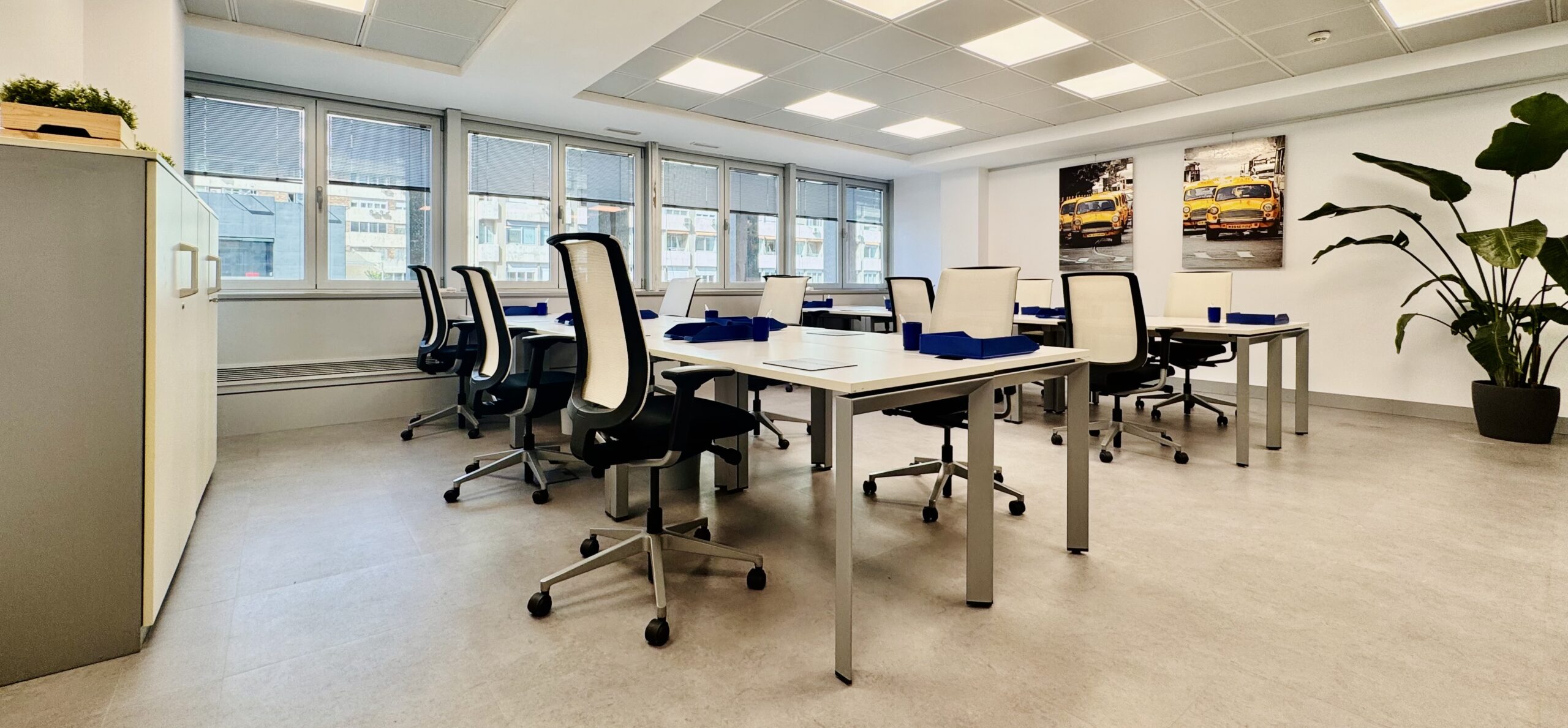In recent years, we have witnessed a remarkable transformation in the way we think about workspaces. Traditional offices, which for decades represented the basis of the business environment, have had to adapt to new, more flexible and collaborative models, such as coworking and coworking spaces.
This change is not just a passing fad, but a response to the new needs of companies and professionals, who are looking for more versatile, economical spaces that encourage creativity and connections between people.
Choosing the right working environment has become a key factor in the success of any company, regardless of its size. A space that fits the needs of the company not only impacts daily productivity, but also the satisfaction of the team, the working environment and the image it projects to its customers and collaborators.
Today, more than ever, companies have the opportunity to rethink where and how they want to work, and that decision can make the difference between stagnation and growth in today’s competitive environment.

Coworking spaces
The coworking concept has revolutionised the way we think about working environments in the 21st century. It was born as a response to the new needs of freelancers and growing companies, who were looking for a place where they could develop their activities without the rigidity of a traditional office, but with the advantages of a professional environment.
In essence, coworking is a shared workspace where professionals from different sectors live together under the same roof, using the same facilities, but developing independent projects. This formula has proven to be a catalyst for creativity, innovation and business growth.
One of the most attractive aspects of coworking is its flexibility, both in terms of use and costs. Unlike conventional offices, which require long-term contracts and high fixed costs, coworking spaces offer a much more flexible approach. Companies and professionals can rent a workstation or a private office for days, weeks or months, depending on their needs, which allows them to adapt the space to their work rhythms and business evolution without having to make a long-term commitment. Moreover, in economic terms, coworking represents a considerable saving, as the costs of maintenance, supplies and services, such as internet, cleaning or security, are included in the price.
The savings are not only in financial terms, but also in time and resource management. By outsourcing all operational issues, professionals and companies can focus exclusively on their work, which increases their productivity. At the same time, they have access to quality facilities, such as meeting rooms, break-out areas, kitchen and administrative services, which would otherwise require significant investment.
But coworking is not just about flexibility and savings, it is also about collaboration and networking. These spaces are designed to encourage interaction between people, creating an environment in which ideas flow naturally. By sharing the same space with professionals from different sectors and areas of expertise, the opportunities to generate contacts, collaborate on common projects or even find new clients and suppliers are multiplied. This collaborative approach is one of the great advantages of coworking over traditional offices, where compartmentalisation and isolation are often the norm.
Another of the fundamental characteristics of coworking is the variety of types of spaces it offers. Within a coworking centre, it is possible to find everything from workstations in shared areas, which are usually cheaper and encourage exchange between users, to private offices that allow companies to work in a more reserved and confidential environment, while maintaining the connection with the coworking ecosystem.
In addition, there is a third option that is becoming increasingly popular: hybrid spaces. These combine open and collaborative areas with private areas, allowing users to choose according to the activity they are going to carry out. This diversity of options ensures that freelancers, startups and large companies alike can find a solution that suits their specific needs.
In short, coworking is not just a shared workspace, but an environment designed to adapt to the demands of a changing labour market, where flexibility, cost reduction and networking have become essential. This work model, which started as a trend among freelancers and entrepreneurs, has proven to be an effective solution also for established companies looking for new ways to manage their work more efficiently and dynamically.
The traditional office
Traditional offices have, for decades, been the mainstay of the working environment for businesses of all sizes. This type of workspace is characterised by the fact that it is designed exclusively for a single company, offering complete control over the environment and allowing businesses to tailor every aspect of the space to their needs and preferences.
Unlike coworking spaces, where the environment is shared, the traditional office provides greater stability and personalisation, which is especially important for certain companies that require a space that reflects their corporate identity and internal culture.
One of the great advantages of traditional offices is total control over every aspect of the space. From the layout of work areas to the choice of furniture, décor and technology, companies can design the environment exactly as they wish, aligning every detail with their values and operational needs.
This level of customisation not only creates an atmosphere that reinforces the corporate culture, but also makes it easier to adapt the facilities to the specific demands of each business, whether in terms of privacy, security or technical needs. For example, a company that handles confidential data or needs specific facilities, such as laboratories or servers, will find a traditional office space more suitable than a coworking space.
However, this freedom and control often comes with higher fixed costs and the need to sign long-term contracts. When leasing a traditional office, companies incur ongoing costs, such as rent, maintenance, supplies, utilities and support staff, which often need to be managed in-house.
In addition, contracts often require a multi-year commitment, which implies a considerable investment and less flexibility should the company need to downsize or expand its space. While this format may be ideal for companies seeking stability and control, it can also be limiting for businesses that need to adapt quickly to changes in their structure or in the market.
Another distinctive aspect of traditional offices is the independence and privacy they offer. Unlike coworking spaces, where the environment is more open and shared, traditional offices allow you to work in a completely private environment, without the distractions and potential interruptions that can arise in a shared space. This independence is especially valuable for companies that handle confidential information, such as law firms or consultancies, or those that need to maintain strict control over access to their facilities.
In addition, traditional offices allow greater control over the pace and internal dynamics of the company. Not only can you avoid the noise or constant activity of shared spaces, but you can also regulate the flow of visitors and interaction with outsiders. For many companies, this independence and privacy is crucial to ensure an efficient and safe working environment.
In short, traditional offices offer a space that prioritises total control, personalisation and stability, albeit at the cost of less flexibility and higher fixed costs. This type of environment remains the preferred choice for many companies that value independence, privacy and the ability to shape their space to their specific needs, whether for operational reasons, security or simply because it allows them to maintain a strong and consistent corporate culture in their own unique environment.
Advantages of coworking over traditional office space
Coworking has gained ground over the traditional office due to a series of advantages that make it a very attractive option for professionals and companies looking to adapt to a more dynamic and flexible working environment. One of the main reasons why many opt for coworking is the great flexibility it offers in terms of working hours and space. Unlike traditional offices, which are usually tied to rigid schedules and contracts, coworking spaces allow users to access the facilities 24 hours a day, 7 days a week.
This is especially useful for startups, freelancers and teams that need an environment adaptable to their work rhythms, without being constrained by regular office hours. In addition, flexibility in terms of space is a significant advantage: professionals can rent anything from a single desk to private offices by the day, week or month, as required, without the need for a long-term commitment.
Another key aspect is the reduction of costs and the absence of a long-term contractual commitment, which makes coworking a much cheaper and more accessible option. In traditional offices, companies usually assume high costs not only for renting the space, but also for the maintenance of services such as electricity, internet, cleaning or security, as well as the purchase of furniture and equipment. In contrast, in a coworking space, all these services are included in a single monthly payment, which simplifies financial management and considerably reduces operating costs. In addition, coworking contracts are much more flexible, allowing companies to adjust their space according to their growth or specific needs, without the constraints of a long-term lease. This is ideal for companies that cannot accurately forecast their future needs, such as startups or expanding businesses.
The networking and collaboration potential offered by coworking is another of its great attractions. These spaces not only allow different professionals and companies to share the same place, but are also designed to encourage interaction and the exchange of ideas between users. Working in an environment where people from different industries and sectors live together multiplies the opportunities to establish contacts, collaborate on common projects or even discover new clients and suppliers.
Often, the connections that arise in a coworking space can turn into strategic alliances or new business opportunities, which adds intangible but very important value to this type of environment. In addition, many coworking centres organise networking events, workshops or talks, where members can learn, share experiences and continue to build their network of contacts.
Finally, access to a wide range of shared services is a significant advantage of coworking over traditional offices. Coworking users are not only provided with well-equipped workstations, but also with a range of services that facilitate their day-to-day work, such as fully equipped meeting rooms, advanced technology (projectors, printers, high-speed connections), and reception or administration services.
This allows professionals to concentrate on their activity without having to worry about logistical or technical issues. Moreover, by sharing these services with other users, the associated costs are considerably reduced, resulting in a more economical and efficient environment.
In short, coworking has clear advantages over the traditional office, especially in terms of flexibility, cost savings, and opportunities for collaboration and networking. For many, this model represents the perfect solution for a work environment that increasingly demands adaptability, innovation and efficiency. By offering a space that combines access to quality services with the possibility to interact and collaborate with other professionals, coworking has established itself as an ideal option for those looking for a modern and versatile working environment.
Advantages of the traditional office versus coworking
Traditional offices offer a number of advantages that remain essential for many companies compared to the coworking alternative. One of the main ones is the total control and customisation of the space. Unlike shared coworking environments, where users must adapt to an established layout, in a traditional office the company has the power to configure and adapt the space according to its specific needs.
This makes it possible to create an atmosphere that is fully aligned with the company’s identity, from the furniture to the layout of the work areas. This control also facilitates the integration of customised technologies, specialised equipment or the creation of areas dedicated to specific functions, such as private meeting rooms, executive offices, breakout areas or storage. In a traditional office, the space becomes an extension of the company itself, reflecting its culture and values in every corner.
Another key aspect is the creation and maintenance of a corporate culture. Traditional offices allow companies to develop a unique environment that strengthens the bonds between employees and promotes a strong organisational culture.
Having one’s own space helps to generate a sense of belonging and cohesion among workers, something that can be more difficult to achieve in a shared environment such as coworking, where the identity of the space is diluted among multiple companies and professionals. Traditional offices allow companies to implement their own style of working, develop internal rituals and promote a more defined corporate culture, which is especially valuable for companies looking to build a united and committed team with a shared vision.
Guaranteed security and privacy is another advantage of the traditional office versus coworking. In a coworking environment, even if there are private offices within the premises, there is always a shared component that can make companies more cautious when handling confidential information or sensitive data.
In a traditional office, security is completely under the control of the company. Access control systems, surveillance cameras, private networks and other protective measures can be put in place to ensure that information and daily operations run without risk of leaks or unauthorised access. This is crucial for businesses that deal with sensitive or regulated data, such as law firms, financial consultancies or companies that develop intellectual property.
In addition to security, traditional offices guarantee a higher level of privacy in day-to-day operations. There is no risk that confidential conversations or internal meetings can be overheard by other professionals, as might happen in a coworking space. This privacy is essential for companies that need to handle strategic negotiations, meetings with important clients or simply to ensure a working environment where the necessary discretion can be maintained.
Finally, traditional offices offer less distraction from the environment, which helps to improve concentration and productivity. In a coworking space, sharing the space with professionals from different sectors and companies can lead to distractions, whether from noise, constant movement of people or unplanned interruptions.
While some may find the vibrant atmosphere of coworking stimulating, others may find it a hindrance to concentrating on complex or attention-intensive tasks. In a traditional office, the environment is controlled, and the company can create an environment that encourages focus and efficiency, with more direct control over the rules of coexistence and use of the facilities.
In short, the traditional office remains the preferred option for many companies that value total control over their workspace, the ability to develop a strong corporate culture, security and privacy, and a more focused and distraction-free working environment. While coworking offers flexibility and collaboration, the stability and personalised environment of a traditional office remain essential for companies seeking a more defined workspace under their full control.
The future lies in the hybrid model
The future of work is marked by flexibility, and one of the main emerging trends is the hybrid model, which combines the best of traditional offices with the advantages of coworking. This approach is transforming the way companies and professionals manage their work environments, adapting to a context where the rigidity of old models no longer fits the needs of modern organisations.
The hybrid office offers companies the possibility of having their own space for their teams, but with the flexibility to use shared areas when necessary. This provides a balance between the personalisation of a controlled environment and the collaboration and dynamism of a coworking space.
This new paradigm allows companies and their employees to choose to work in different locations according to the needs of the moment. For example, a company can have a physical office for its core team, but also provide its employees with access to nearby coworking spaces when working away from headquarters or in different cities. In this way, the hybrid model not only optimises the use of space, but also provides greater freedom and comfort to workers, adapting to the mobility and flexibility demanded by today’s world.
The rise of remote working has also been one of the key factors driving this change. The COVID-19 pandemic accelerated the adoption of telework, and many companies have seen the benefits of allowing their employees to work from home or anywhere. While remote working has proven to be effective in many cases, it has also shown certain limitations, such as the lack of personal interaction or the difficulty of separating work and personal space.
That’s why the hybrid model combines the best of both worlds: it offers the flexibility of remote working, allowing employees to perform their tasks from home or a shared office, while retaining a physical space that promotes collaboration and a sense of belonging when more face-to-face or team-based work is required.
This change in the way we work is directly affecting workspaces, which must adapt to this new reality. Large permanent office spaces are beginning to give way to more flexible and adaptive spaces, where companies can rent areas according to their current needs, whether by project, season or team size.
This also encourages the growth of coworking spaces, which have evolved to offer flexible solutions to large corporations, not just freelancers or startups. The possibility of having access to different spaces in different cities or countries without the commitments of a traditional office is one of the great attractions of this hybrid model.
Technology plays a crucial role in the future of workspaces and in the success of this hybrid model. Digitalisation has facilitated the implementation of tools that allow employees to collaborate efficiently, no matter where they are.
From high-quality video conferencing to project management platforms and virtual private networks, technology is the engine that enables teams to stay connected, productive and organised. The offices of the future will be equipped with cutting-edge technology, from intelligent space management and reservation systems to advanced connectivity solutions that allow employees to move seamlessly between face-to-face and remote work.
In addition, smart workspaces are starting to become a reality. These spaces incorporate sensors and technology to optimise the use of space, from lighting to air conditioning, improving not only energy efficiency but also employee comfort. The offices of the future will also be equipped with tools that facilitate both face-to-face and virtual collaborative work, such as interactive whiteboards and augmented reality software that allows teams to work on projects in real time, even if they are in different locations.
In short, future trends point towards a hybrid model where the flexible office becomes the centre of operations, but not exclusively so. Combining traditional spaces with coworking and teleworking offers companies the ability to adapt quickly to change, optimising both resources and employee productivity. This approach, enhanced by technological advances, is transforming the way we think about workspace, opening the door to a future where work will be more dynamic, flexible and connected than ever before.
Conclusion
In conclusion, both coworking and traditional offices offer distinct advantages that suit the different needs of professionals and companies. While coworking stands out for its flexibility, cost savings and ability to foster collaboration and networking, traditional offices provide full control over the space, security and privacy, as well as the possibility to create a strong corporate culture.
One of the key points is that coworking is ideal for companies and freelancers looking for adaptability and a dynamic environment, with the possibility to quickly adjust their workspace according to their changing needs. On the other hand, traditional offices remain the preferred option for companies that value stability, total customisation of the environment and protection of sensitive data. Office rental in Madrid, for example, remains a popular solution for companies that need a fixed, dedicated space in a strategic location.
Ultimately, the future of work environments seems to be heading towards a hybrid model that combines the best of both worlds: the flexibility of coworking and the stability of traditional offices. Striking the right balance between these two realities will be essential for companies wishing to optimise their performance, maintain a healthy working environment and, at the same time, be able to adapt to the changes and challenges of today’s market. The key is to choose the environment that best suits the particularities of each business, always taking into account its short and long term goals.






